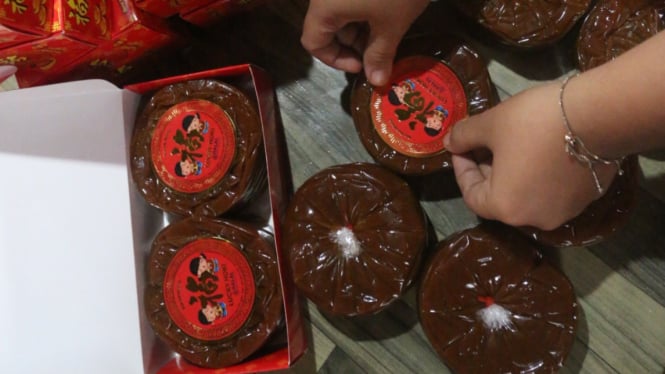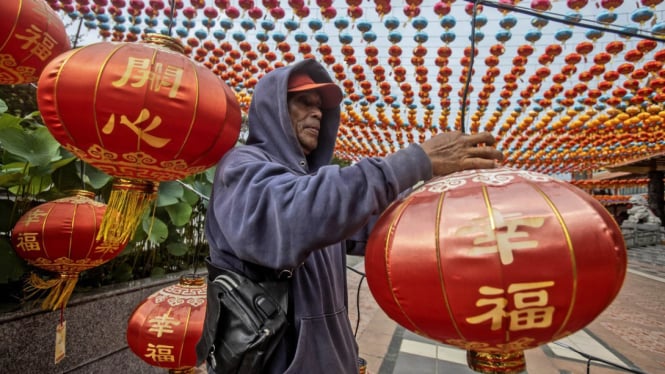10 Unusual and Weird Wedding Traditions from Around the World
- U-Report
VIVA – Marriage is a sacred event of the union of a man and a woman who love each other. Every country has different traditions for weddings. Usually, the tradition is determined by the customs and provisions of each country.
Indonesia has a unique tradition at weddings, namely Pingitan. This tradition in the Javanese traditional wedding process requires that the bride-to-be is prohibited from leaving the house or meeting the groom-to-be for a specified time.
It turns out, not only Indonesia has a unique tradition at weddings, but also around the world. Here are some countries with unusual and weird wedding traditions.
1. Beating the Groom's Feet (South Korea)
After their wedding ceremony, some South Korean grooms undergo a certain ritual before they can go out with their new wives, such as to do their foot beating.
The groomsmen or members of his family remove the groom's shoes and tie his ankles with rope before taking turns hitting his feet with sticks or, in some cases, dried fish.
While painful, the ritual ends quickly and is meant to be more entertaining than punitive. It is a form of strength and character.
2. Spitting on the Bride (Kenya)
Ilustrasi pernikahan
- postgradproblems.com
During Kenyan Maasai weddings, the father of the bride would often spit on her daughter's head and breasts before she left with her new husband. In a Maasai culture where spitting is seen as a symbol of good luck and fortune.
Spitting can also be seen in other areas of the Maasai culture, the Maasai will spit on their hands before shaking hands with an elder as a sign of respect and it is also a tradition to spit on a newborn Maasai baby to ward off bad luck.
3. Blackening (Scotland)
In parts of Scotland, the groom and bride-to-be are subjected to a very dirty ritual, known as Blackening.
Usually occurring the day before the wedding, the blackening involves the bride's friends or the groom seizing the soon-to-be-wed bride and covering her with a mixture of brown sugar, soot, feathers, and flour before parading her noisily through the streets.
According to the University of the Highlands, the tradition is carried out to ward off evil spirits.
4. Kumbh Vivah (India)
India: Kumbh Vivah
- theculturetrip
In India, women born under the Mangal Dosha (a combination of Hindu astrology) are called 'Mangliks' and are thought to be cursed with bad luck, especially in marriage, where the curse is said to bring tension and even death.
To handle this, Kumbh Vivah is a ceremony where women marry a peepal or banana tree or an idol of the god Vishnu performed before their actual wedding to break the curse.
5. Polterabend & Baumstamm Sagen (Germany)
Ilustrasi cincin pernikahan.
- Ist.
On the night of weddings in Germany, guests of the couple will gather at the bride's home and break glassware in a tradition known as Polterabend which is believed to bring good luck to the bride and groom.
The couple was then asked to clear away the debris to show that by working together they could overcome any challenges faced in married life.
A similar tradition is the Baumstamm Sagen tradition, where newlyweds see a half log in front of their guests, symbolizing the importance of cooperation in their marriage.
6. Ritual of Crying (China)
In China, the ritual of crying is treated in preparation for marriage. A month before their upcoming wedding, the Tujia bride would cry for an hour every day.
Ten days into the ritual, the bride joins her mother, and ten days after that, the bride's grandmother joins the crying duo, and eventually, other female family members will join to cry.
7. Le Pot de Chambre (France)
While we may associate France with haute cuisine, the belly-stirring French wedding tradition known as La Soupe is a far cry from the cordon bleu you can get.
After the wedding reception, guests will traditionally collect leftovers and drinks and place them in pots before serving them to the newlyweds to drink, which should give them energy for their wedding night.
8. Borneo's Bathroom Ban (Malaysia and Indonesia)
Ilustrasi pernikahan.
- U-Report
Members of the Malaysian and Indonesian Tidong communities in Kalimantan follow the tradition of the bride and groom not leaving their homes or using the bathroom for three full days after the wedding ceremony.
They are strictly guarded and only a small amount of food and drink is allowed. In Tidong culture, not observing the ritual is said to taint the bride and groom with bad luck which often results in infidelity, the breakup of their marriage, or the death of their children.
9. You May All Kiss The Bride (Sweden)
Mempelai wanita.
- U-Report
In Sweden, the kissing ritual is taken to a whole other level. At the wedding reception of newlywed Swedish couples, if the groom should leave the room the male guests of the bridal party are permitted to kiss the bride. Similarly, if the bride leaves the party female guests will hone in to kiss the groom.
10. Killing Chicks (Inner Mongolian)
Anak ayam cemani
- http://asalasah.blogspot.com
In a Mongolian wedding tradition, a couple from the Daur tribe in Inner Mongolia must raise a chick. The couple must take a knife and kill and gut together the baby chick before examining its liver.
If the chick liver is in good health, the couple can set a date for their wedding but if they find that the chick liver is of poor quality or diseased, they have to repeat the process until they find a healthy liver.





































